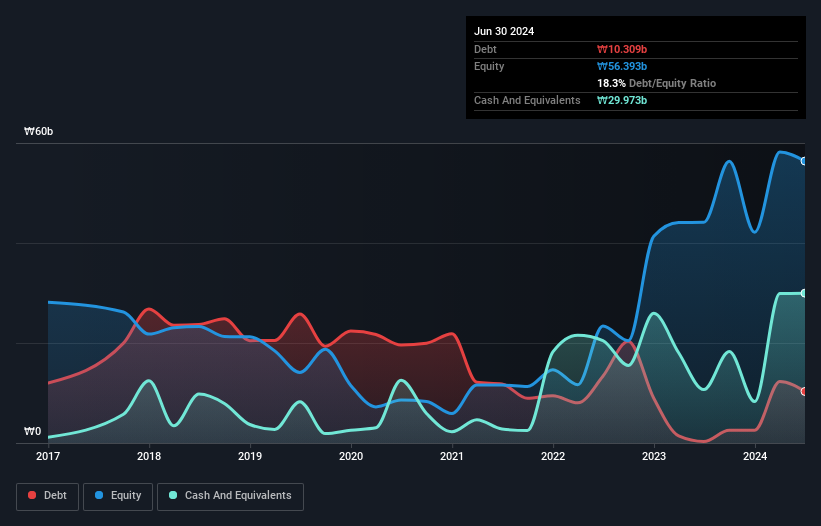- South Korea
- /
- Communications
- /
- KOSDAQ:A175140
HUMAN TECHNOLOGY (KOSDAQ:175140) Has Debt But No Earnings; Should You Worry?
David Iben put it well when he said, 'Volatility is not a risk we care about. What we care about is avoiding the permanent loss of capital.' When we think about how risky a company is, we always like to look at its use of debt, since debt overload can lead to ruin. As with many other companies HUMAN TECHNOLOGY Co., Ltd (KOSDAQ:175140) makes use of debt. But the more important question is: how much risk is that debt creating?
Why Does Debt Bring Risk?
Debt and other liabilities become risky for a business when it cannot easily fulfill those obligations, either with free cash flow or by raising capital at an attractive price. Part and parcel of capitalism is the process of 'creative destruction' where failed businesses are mercilessly liquidated by their bankers. However, a more frequent (but still costly) occurrence is where a company must issue shares at bargain-basement prices, permanently diluting shareholders, just to shore up its balance sheet. Of course, plenty of companies use debt to fund growth, without any negative consequences. When we think about a company's use of debt, we first look at cash and debt together.
View our latest analysis for HUMAN TECHNOLOGY
How Much Debt Does HUMAN TECHNOLOGY Carry?
As you can see below, at the end of June 2024, HUMAN TECHNOLOGY had ₩10.3b of debt, up from ₩300.0m a year ago. Click the image for more detail. But on the other hand it also has ₩30.0b in cash, leading to a ₩19.7b net cash position.

How Healthy Is HUMAN TECHNOLOGY's Balance Sheet?
We can see from the most recent balance sheet that HUMAN TECHNOLOGY had liabilities of ₩21.7b falling due within a year, and liabilities of ₩767.5m due beyond that. On the other hand, it had cash of ₩30.0b and ₩4.65b worth of receivables due within a year. So it actually has ₩12.1b more liquid assets than total liabilities.
This surplus suggests that HUMAN TECHNOLOGY has a conservative balance sheet, and could probably eliminate its debt without much difficulty. Succinctly put, HUMAN TECHNOLOGY boasts net cash, so it's fair to say it does not have a heavy debt load! When analysing debt levels, the balance sheet is the obvious place to start. But you can't view debt in total isolation; since HUMAN TECHNOLOGY will need earnings to service that debt. So when considering debt, it's definitely worth looking at the earnings trend. Click here for an interactive snapshot.
In the last year HUMAN TECHNOLOGY wasn't profitable at an EBIT level, but managed to grow its revenue by 49%, to ₩42b. With any luck the company will be able to grow its way to profitability.
So How Risky Is HUMAN TECHNOLOGY?
Statistically speaking companies that lose money are riskier than those that make money. And the fact is that over the last twelve months HUMAN TECHNOLOGY lost money at the earnings before interest and tax (EBIT) line. And over the same period it saw negative free cash outflow of ₩12b and booked a ₩16b accounting loss. But at least it has ₩19.7b on the balance sheet to spend on growth, near-term. HUMAN TECHNOLOGY's revenue growth shone bright over the last year, so it may well be in a position to turn a profit in due course. Pre-profit companies are often risky, but they can also offer great rewards. There's no doubt that we learn most about debt from the balance sheet. But ultimately, every company can contain risks that exist outside of the balance sheet. To that end, you should learn about the 3 warning signs we've spotted with HUMAN TECHNOLOGY (including 1 which can't be ignored) .
If you're interested in investing in businesses that can grow profits without the burden of debt, then check out this free list of growing businesses that have net cash on the balance sheet.
Valuation is complex, but we're here to simplify it.
Discover if HUMAN TECHNOLOGY might be undervalued or overvalued with our detailed analysis, featuring fair value estimates, potential risks, dividends, insider trades, and its financial condition.
Access Free AnalysisHave feedback on this article? Concerned about the content? Get in touch with us directly. Alternatively, email editorial-team (at) simplywallst.com.
This article by Simply Wall St is general in nature. We provide commentary based on historical data and analyst forecasts only using an unbiased methodology and our articles are not intended to be financial advice. It does not constitute a recommendation to buy or sell any stock, and does not take account of your objectives, or your financial situation. We aim to bring you long-term focused analysis driven by fundamental data. Note that our analysis may not factor in the latest price-sensitive company announcements or qualitative material. Simply Wall St has no position in any stocks mentioned.
About KOSDAQ:A175140
Adequate balance sheet with slight risk.
Market Insights
Weekly Picks


Crazy Undervalued 42 Baggers Silver Play (Active & Running Mine)


Fiducian: Compliance Clouds or Value Opportunity?

Willamette Valley Vineyards (WVVI): Not-So-Great Value
Recently Updated Narratives

Watch Pulse Seismic Outperform with 13.6% Revenue Growth in the Coming Years

Significantly undervalued gold explorer in Timmins, finally getting traction

Moderation and Stabilisation: HOLD: Fair Price based on a 4-year Cycle is $12.08
Popular Narratives


MicroVision will explode future revenue by 380.37% with a vision towards success


NVDA: Expanding AI Demand Will Drive Major Data Center Investments Through 2026





